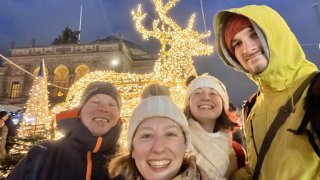
"Has it always gotten dark this early?" I've asked myself every December, on cue, since moving to Odense, a city on the Danish island of Funen, in late 2018.
Denmark experiences a distinct lack of daylight between October and March, prompting many residents to spend time under sun lamps and take supplemental Vitamin D.
Although December is the darkest month on average, the gloom is counteracted in part by the twinkly lights strung throughout the cities and general Christmas cheer. Once New Year's has passed, the infamously dark and cold winters weigh heavily on most people — at least until we start waking up after sunrise again in March.
Starting last year, I resolved to not let the winter blues get me down. I'm excited to keep this season actively merry and bright.
Get top local stories in San Diego delivered to you every morning. Sign up for NBC San Diego's News Headlines newsletter.
Embracing holiday traditions and delicious food
Denmark doesn't have as many national holidays as the U.S. With the exception of informal celebrations like Sankt Hans in honor of the midsummer solstice, and Mortensaften, when Danish families enjoy duck to celebrate the start of winter, it's mostly a straight shot from Easter to Christmas.
That's why I find it helpful to keep American fall and winter traditions. I dress up for Halloween (it's on the rise in Denmark!), and I host Friendsgiving with at least three types of pie.

In addition to regularly making pumpkin pie (this vegan version is my favorite) and cranberry sauce, I try out new Danish recipes, like ones for romkugler (cake balls flavored with rum essence) and æbleskiver (spherical pancakes served with jam and powdered sugar).
I once joined an event from the Danish Celiac Association (Dansk Cøliaki Forening), which caters to people, like me, with celiac disease. Together we baked gluten-free fastelavnsboller, a pastry connected to the Carnival tradition of Fastelavn, which falls in February or early March depending on the year.

Winter is a great excuse to visit nearby towns for a change of scenery.
Money Report
Last year, I traveled to Vejle — a fjord-side city that's a 40-minute train ride from Odense — to see how they ushered in the Christmas season: A car, bedecked with rainbow Christmas lights and a mannequin Santa, drove up and down the main shopping street.
Creating coziness by spending time with friends
The Danish concept of hygge is well-known but widely misunderstood. Though the word translates roughly to "coziness," the American conception usually relies on candles, blankets, and a warm drink. While these things are often present during cozy moments, in my experience, hygge is more about a feeling or an atmosphere created between people who feel comfortable together.
Danes are known to plan their social calendars months in advance, especially during the festive season. While this can make it difficult to make new friends outside of an established circle, internationals who follow the Danes' lead can more easily ward off the winter blues.

Creating and keeping rituals helps cultivate a feeling of coziness. I love inviting friends to go on coffee dates, take walks, or try out different cocktail and wine bars before monthly karaoke events.
Although I admit I've wanted to skip my thrice-weekly bouldering sessions once it gets dark outside — it's just so hard to face the cold — the ritual gives me something to look forward to. My friends and I often cap off our sessions with a coffee or hot chocolate, and we've been known to visit the Christmas markets in Copenhagen.
At its most basic, beating the cold involves staying busy, getting outside, and doing something fun with people you enjoy spending time with, no matter the activity! I just attended a wine tasting with one friend, and another has suggested we start a ceramics-making course.
When we reflect on times we've enjoyed together, it's common to say, "Det var så hyggeligt." The longer I've lived here, the more I've begun saying its rough translation, too: "That was so cozy."
Going winterbathing for a 'joyful and euphoric' reset
At the start of December, my partner and I went to the public pool at Odense harbor at 7 a.m., sitting in 5.6°C (42°F) water in two- to five-minute stints as we watched the sky acquire its first few rays.
Vinterbadning, or winterbathing, is a tradition where Danes alternate dips in cold water with stints in the sauna. I first learned about it on Archipelago, a podcast hosted by James Clasper, a fellow expat in Denmark.

Since February 2024, I've visited the Odense harbor pool regularly to experience something like a "reset" of my body and mind. Upon emerging from the cold water, I feel joyful and euphoric. It's amazing, though perhaps not for the faint of heart!
Afterwards, I like to treat myself with a visit to the local bakery to warm up with a cortado and a gluten-free pastry while watching the sky get lighter.
At the end of the day, I've found that keeping my calendar full, sharing new and old traditions, and leaning into rituals allows me to find warmth and light, no matter the forecast.
Chloé Skye Weiser is an avid storyteller and journalist who writes about coffee culture, climate, circularity, and sexual and reproductive health and rights. Originally from NYC, she currently lives in Denmark. She is the founder of content strategy firm Chlohemian Copy. You can connect with her on LinkedIn or Instagram.
Want to make extra money outside of your day job? Sign up for CNBC's online course How to Earn Passive Income Online to learn about common passive income streams, tips to get started and real-life success stories.






